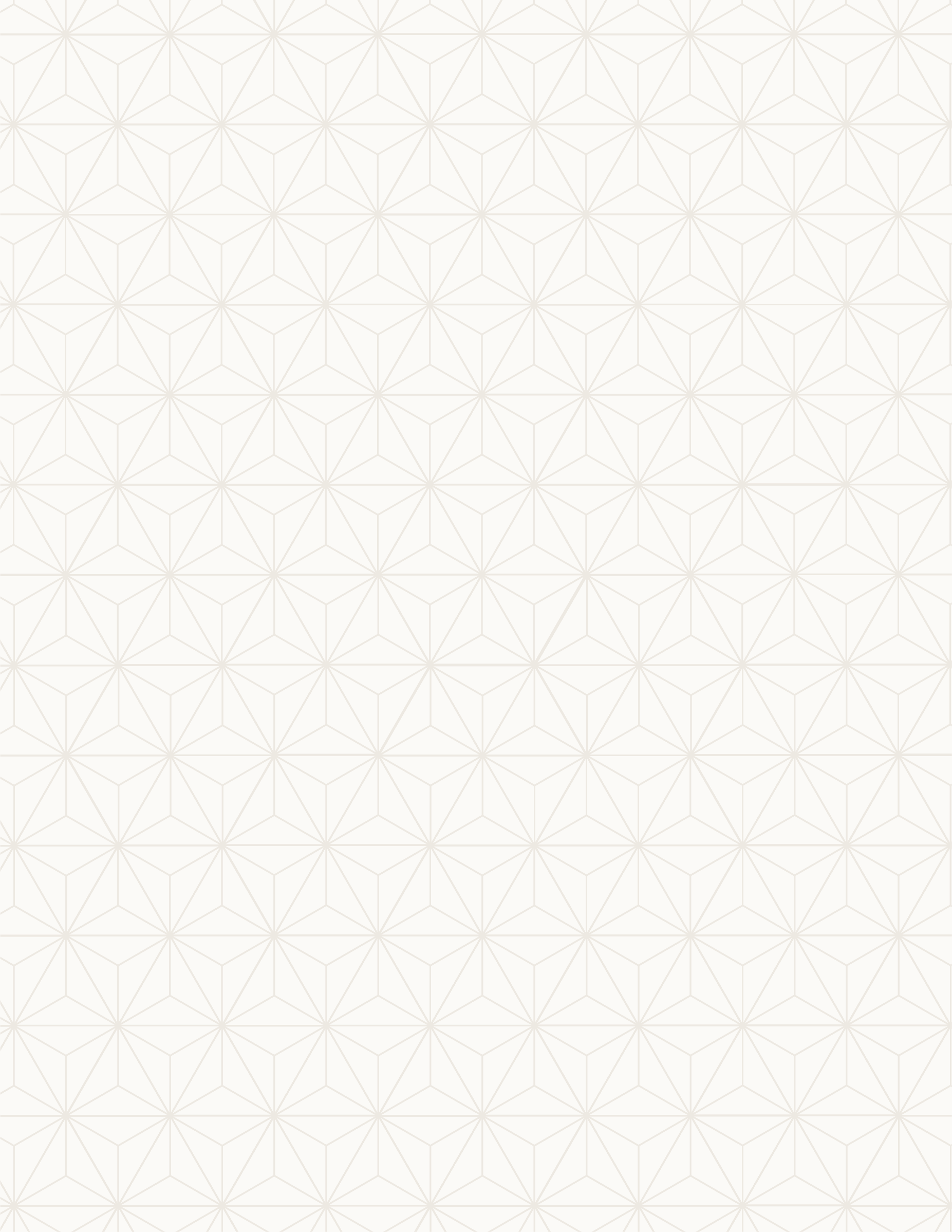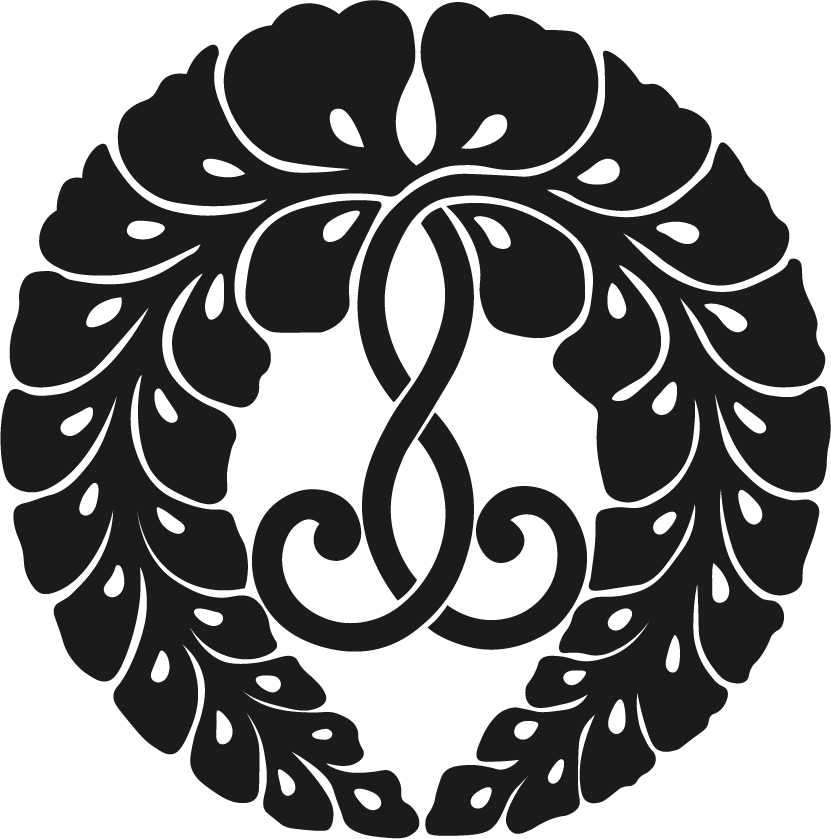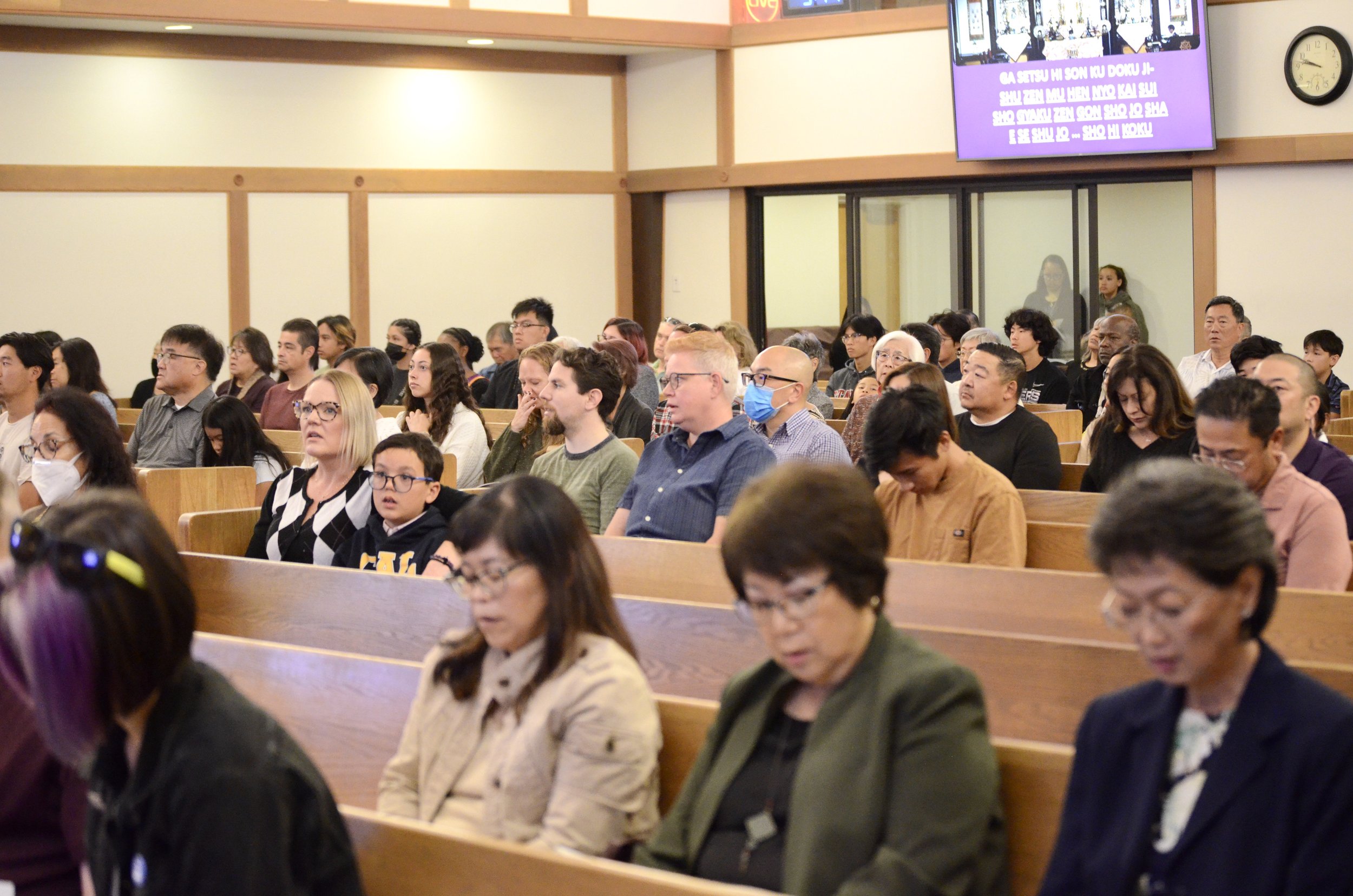
Visit us for a service
There’s nothing like attending a service at our temple in person (although our live-streamed services are a close second!). Come in and meet our members, start your week with a Dharma talk, and enjoy a snack after service with us in our Courtyard.
To learn more about what to expect during your first visit, click here.
To watch a service live on our YouTube channel, click below.
Along his journey to becoming a minister, Reverend Yuki Sugahara played in a rock band in Japan. Today, he connects his Dharma talks with memorable performances on his bass guitar, treating our Sangha community to all genres of music including classical, jazz, and pop.
Shotsuki Hoyo Service
On the first Sunday of every month, we observe a special memorial service known as Shotsuki Hoyo. This service is dedicated as a time to remember and express gratitude for our family members and friends who have passed away during the month of the year in which the service is held.
To submit names of loved ones for a special reading at a monthly Shotsuki Hoyo service, please complete this form and submit it to the office.
If you have a Homyo card for your loved one(s), you are welcome to bring it to service to be placed on the Onaijin.
Although not required and not expected, we are grateful for any Shotsuki Hoyo donations. If you would like to send a check, please include “Shotsuki” and the name of your loved one in the memo so we can acknowledge your contribution properly. Or you may make a donation online.
Video clip of the minister reading names submitted for those who have passed in the month, followed by the presentation of names of all temple members who have passed away in the month of the year.
-
Usually, a temple will designate one Sunday per month as a monthly memorial service. Then, all the names of the temple members who had passed away that month will be read and during the sutra chanting, the family members will offer incense or oshoko. But why do we do this and where does it come from?
The service can be traced back to Japan. The history beyond that is difficult to trace exactly to the root, but there is influence from Chinese traditions, although it’s hard to say exactly what it is. Nonetheless, in Japan, they do not have regular Sunday service. Instead, the families may go to the temple for everyday morning service or for special occasions. For memorial services, the minister will actually go to the families’ houses. This is why it is important for each house to have an obutsudan, or home altar.
The word Shotsuki comes from Shotsuki Meinichi. Meinichi is translated as “death anniversary” but literally means (mei 命) life (nichi 日) day. Sho (祥) means auspicious and tsuki (月) means month. So the day and the month on which someone passed away every year, the minister would come to the house and do a service for the person (or people) who passed away on that day. Some homes even observe a Tsuki Meinichi, meaning that every month on the day someone passed away they would have a service.
Looking at the meaning of the words, we see that it isn’t such a sad or depressing event. “Life day” and “auspicious month” have more of a lucky or grateful feeling. And the word Hoyo is composed of the characters ho (法) meaning Dharma and yo (要) meaning essential point.
Together we understand that the Shotsuki Hoyo is an opportunity for us to show gratitude to the loved ones who have been integral to our lives. It is also an opportunity to come into contact with the teachings of the Buddha and the true reality of our existence. By having a service every year, we keep the memory of our loved ones alive and respect and honor them by reflecting on how they continue to influence our lives.
Upcoming Services
We offer weekly services on Sunday and Wednesday mornings, all which are free and open to the public.
Please hover and click the individual service for more information or head to our Community Calendar for next month’s schedule.

What to expect during your first visit
We offer many different types of services at our temple, but the most commonly attended is our Sunday Dharma Service. Below is an outline of the format that these Sunday services typically follow. Many of our Dharma services are also recorded and can be watched on our Youtube channel.
-
Service begins at the sound of the Kansho bell (calling bell). Everyone seated will begin quieting their conversations. As the service begins, the Sangha reamains seated in quiet meditation and/or with their hands pressed together in Gassho.
-
The attending ministers will walk onto the altar space, called the Onaijin, during the ringing of the Kansho bell.
-
The chairperson will give an opening message and meditation, followed by an announcement of our opening Gatha, or song.
-
The minister will lead the congregation in a selected reading, often either “Three Treasures” or “Golden Chain”.
-
Minister will lead chanting following selected reading. The page number will be announced so that you may follow along in the service book or on the screens in the Hondo. Common sutra chantings for Sunday Dharma services are Juseige or Junirai.
-
After the Sutra Chanting, selected representatives from the “Sangha” (Congregation) will be asked to “Oshoko” or offer incense. These groups are often selected organizations or classes from Dharma School. General members or visitors will not be asked to Oshoko without prior notice.
Sunday Dharma Service Format
-
The minister will lead the congregation in a second selected reading, often either “Three Treasures” or “Golden Chain”, depending on what was recited during the first reading.
-
The reverend, minister’s assistant, or guest speaker will share a message, similar to a sermon, that revolved around our Buddhist teachings.
-
Selected song and music accompaniment, followed by a closing meditation by the service chairperson.
-
Before the service is concluded, there is an opportunity for Sangha (congregation) members to share relevant community announcements at the chairperson’s podium.
-
The end of the announcements concludes the service. Everyone present at the service is invited to Oshoko (Offer Incense) at the front of the Hondo before exiting. A line typically forms down the middle of the Hondo for those who would like to Oshoko. If you would not like to offer incense, we recommend exiting through the back doors or walking around the far right side of the pews towards the front exit.
-
Join us after service for coffee and snacks in our Gym (Kaikan) or Courtyard. This is a great time to meet new faces, chat with friends, and ask any questions you might have.
Practices and Traditions
If you’ve been wondering how to offer incense or where we gather for service you’re in the right place!
Here, you’ll find walkthroughs, how-to’s, and explanations of common service practices and traditions that you might observe during your visit.
How to Oshoko (Incense Offering)
The literal translation of Oshoko is “burning incense”, but we often use this word to represent to act of offering incense. Many practices in Jodo Shinshu Buddhism are exercises in being mindful. Follow these three easy steps next time you Oshoko!
What is an Onenju?
The Onenju, or Ojuzu as some people refer to them, were originally used as counting beads. But in our Jodo Shinshu tradition, they are a symbol of the 108 bonno (blind passions) that influence our lives. So the Onenju serves as a way to be mindful of these things as we put our hands together in Gassho (literal meaning is “palms pressed together”).
Best Practice: It is customary to wear or hold your onenju in your left hand!
What is the Hondo?
The Hondo is the main hall of the temple where services take place. When we enter this room, it is customary to bow at the doorway, a mindful reminder that we are entering a place of peace and respect. Before exiting, you should also turn and face the altar, and bow again to show mindfulness and appreciation.
We ask that you refrain from eating, drinking, using your cell phone, and talking during the service. We recommend putting any phones on silent or Do Not Disturb so that you can remain fully present for the hour!
There are two rooms at the rear of the hall which have sliding glass doors that can be closed if you have small children that need a break during a service.
It is also respectful to bow if you ever cross in front of the Amida Buddha which is the central figure on the altar.
Temple Etiquette FAQs
-
At our services, you’ll see some members in their Sunday best, and some in more casual outfits, like a sweater and jeans. We recommend wearing nice, casual clothing, such as pants, polos, sweaters, jeans, or closed-toe shoes.
-
For your first visits, you only need to bring yourself! If you have prayer beads (Onenju or Ojuzu), you are welcome to bring those to use throughout the service, but they are not required.
-
All Sunday and Wednesday Dharma services are free and open to the public. Donations are always appreciated, but not required to attend!
If you would like to make a monetary donation at the service, there are two wooden donation boxes (Osaisen-bako) as you enter the Main Hondo, each located
on either side of the main aisle, behind the pews. Donations can also be dropped off at our Office. All Dharma Service donations (Osaisen) go to support the activities of our Sunday Dharma School classes and program.
-
Yes! Our services and temple community are very family-friendly.
There are times during service when we do ask that the Sangha (congregation) quiet all personal conversations. If you or your child ever need to take a break, we have a children’s room in the back of the Main Hondo that is specifically set up with quiet activities and books for young children. The service is played on speakers so that you will still be able to listen to the ministers and program.
Many of our Sunday Dharma Services are followed by Dharma School (Sunday School for K-12th Graders). If you are interested in enrolling your children, please visit our Dharma School page to learn more!
-
Whether or not you are Buddhist, here are a few helpful tips for visitors:
We respectfully ask that everyone silence their cell phone when entering the Main Temple (Hondo).
At the entrance to the Hondo, it is customary to bow toward the Main Altar (Onaijin), both when entering and leaving.
You can sit anywhere you like and can find a seat by using the aisles on the outside of the pews (as opposed to the center aisle).
Listen attentively to the Dharma message, sing along with the Gathas, and participate in the chanting if you’re comfortable! Your experience will be richer from it.
After service, please plan to join us for coffee and snacks, either in the Courtyard (in nice weather) or in the Kaikan (gym). It’s always a wonderful time to meet people, share your experience, and ask questions!
Something else on your mind?
Contact us
2401 Riverside Blvd
Sacramento, CA 95818-2233
Visit us






